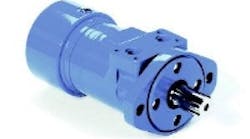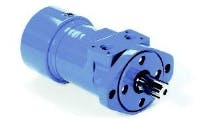Low-speed, high-torque motors are the essence of fluid power. They deliver more power in a smaller package than any other form of power transmission. Add to this an integral fail-safe ( pressureapplied, spring-released) brake, and you've got a package no other technology even comes close to.
Char-Lynn brand brake motors have carried on this tradition for decades. Manufactured by Eaton Hydraulics, Eden Prairie, Minn., Char-Lynn Tbrake series motors now include an internal brake release that reduces installation cost by eliminating the need for external hoses or fittings to plumb to a brake release port.
With the Char-Lynn internal release design, hydraulic pressure that disengages the brake is transmitted from the motor case area to act on a brake piston. Because the brake can be actuated from case pressure, external hoses or fittings are not needed, resulting in a much cleaner package with fewer opportunities for leaks.
The brake is integral to the motor's geroller pumping element, creating a 6:1 gear reduction between the brake and the output shaft of the motor. This means the brake has to hold only 1/6 of the torque seen at the output shaft to keep the motor shaft from turning. Front-mounted brakes are not able to take advantage of this internal gear reduction; as such, they must be much larger to hold an equivalent load.
The new design allows the motorbrake package to be 20% shorter and almost 50% lighter than motors with a conventional front-mounted brake. Char-Lynn T-Brakes come in standard displacements from 2.2 to 22.6 in. 3 with multiple mounting configurations, shafts, seal options, and other special features. Additionally, Eaton offers a variety of bolt-on manifold blocks that include counterbalance, relief, and shuttle valves.
For details, call (888) 258-0222 or visit www.hydraulics.eaton.com/tbrake.


